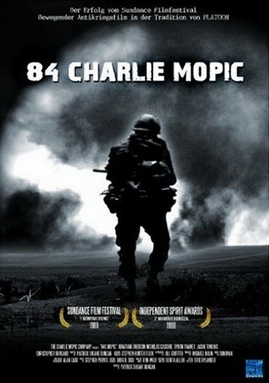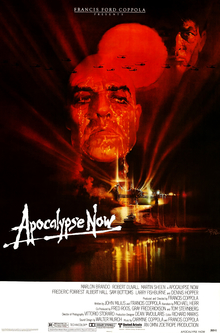VS.
CLICHES
“Hamburger
Hill” has several classic war movie clichés. Some are particular to the Vietnam
War. There is a scene that emphasizes the cluelessness of the media about the
true nature of the war. The soldier who is short is doomed to die before he can
enact the joyful homecoming that he brags about. Two standards are updated for
the war. A character receives a “Dear John” letter, but his girl friend advances
one of the film’s themes by explaining that she is jilting him because of her
anti-war college friends. There is the trite appearance of “Hanoi Hannah” who
makes the obligatory reference to their unit. We also get the guy who talks
about the car he is going to buy back in “the world”. Even though the movie
focuses on the five replacements, that does not stop it from killing them off.
On the other hand, the unit is not overtly heterogeneous and the grunt who shows
off his girl friend’s picture does not die.
C“Platoon” also has several classic war movie
clichés. In fact almost immediately we get a double dose with the fat guy
ensuring his doom by showing off a picture of his girl. The movie helped
establish some uniquely Vietnam tropes. The LT is green and incompetent. The
sergeants run the platoon. There is a psycho in the unit who enjoys the killing.
The incompetent leader calls in the wrong coordinates, resulting in a friendly
fire incident. In one refreshing twist, the short-timer (King) is evaced before
the final battle. The unit is heterogeneous, but not in a barracks
identification scene sort of way.
CFIRST QUARTER
SCOREHamburger Hill =
7
Platoon = 7DIALOGUEThe dialogue in HH could be
described as stilted and it tries too hard to sound authentic to the way the
grunts talked. I have read a lot of eye-witness accounts and found several of
the lines and the sincerity with which they were uttered to be laughable. There
is a monologue by Worchester about his experience back home that is painful to
listen to because it is so melodramatic. On the positive side, for those who
have not read a lot on the war, you do get the greatest slang hits.
C“Platoon” was written by a combat veteran and
although Stone can be faulted for excesses in many of his movies, his dialogue
is restrained in this film. He interweaves slang into the soldier speak in a
natural way. There are some fine dialogue driven scenes like when Elias explains
the evolution of his war view to Taylor. The companion scene with Barnes in the
doper’s bunker nicely bookends this. There are some great lines and they are
spread a out among the characters. Some are critical of Taylor’s narration, but
I feel that although flowery at times, it does add to the theme of lost
innocence.
AHALF TIME SCOREHamburger Hill = 14
Platoon = 16IMPLAUSIBILITIESHH does not
have any glaring implausibilities. The most ridiculous moment is a key moment in
the film. Worcester recounts his return to the states and the litany of abuses
he encountered. It is a montage of urban myths about the treatment of returning
vets. Hippies throw dog poop on him, a hippie is shacked up with his wife, and
everyone he meets is hostile. This is gross exaggeration pushed by the
anti-anti-war movement. The film fulfills the short-timer must die by putting
McDaniel on point. This would have been highly unlikely in reality. Similarly,
when Duffy takes a bullet in the shoulder, he is not sent back off the line. The
movie offers a lame excuse for this. As is typical for most war movies,
artillery fire support is called in much too close to the friendlies.
BMuch of the implausibilities in “Platoon” are
designed to advance the main plot theme of the dysfunctional platoon dynamics.
The whole idea of a platoon divided not only between two sergeants, but divided
into dopers and boozers is clearly a plot device. Resolving this with two
fragging incidents is pure Hollywood. However, most of the incidents that
develop the theme are plausible, including the atrocity.
BTHIRD QUARTER
SCOREHamburger Hill =
22
Platoon = 24EDUCATIONAL VALUEYou can learn a few things
from HH.
1. The Chieu Hoi program encouraged VC to defect to the ARVN. (In
the movie, the defector is NVA and he is helping the U.S. Army.)
2. The NVA
were nicknamed “Nathanael Victor” as opposed to “Charlie” for the VC.
3. The
NVA were respected by the Americans and were worthy adversaries.
4. Contact
with a single enemy would bring an American unit to ground.
5. New guys
(FNGs) were not welcomed with open arms.
6. There were racial tensions in
units, but the closer to the front line, the more the men put color behind them.
There was an unofficial segregation of the races in the rear areas.
7. The
Battle of Hamburger Hill is pretty accurately portrayed, but the movie flubs a
teachable moment by not including a post script pointing out that the hill was
abandoned soon after its bloody conquest. Probably purposefully because this
historical fact clashed with the theme of flogging the anti-war movement.
BAlthough not based on an actual battle,
Stone insists the incidents and characters in his film are based on his Vietnam
experience. Taken as just a tutorial on the Vietnam experience, “Platoon”
teaches a number of things to an audience not well-read on the
subject.
1. Replacement soldiers (i.e. Cherries) were treated like
dirt.
2. Sergeants ran the platoons in many cases.
3. Every soldier knew how many days
that they had left in their tour.
4. If a Vietnamese civilian ran, it was
assumed they were the enemy and you could shoot them.
5. Villages were burned
if they were considered sympathetic to the Communists.
6. Some soldiers
injured themselves to get out of combat.
7. Volunteers felt they were
fighting for our society and freedom.
8. Latrine waste was burned using
kerosene.
9. Drug and alcohol use was common in rear areas.
10. Young Americans
sometimes committed atrocities due to stress or revenge.
11. The Vietnam War
gave some sociopaths an outlet.
AFINAL SCOREHamburger Hill = 30
Platoon =
33ANALYSISThis is my fourth March
Madness tournament and once again the #1 seed does not win. I suppose this is
partly explained by using “Rotten Tomatoes” for the seeding. My theory is that
generic movie critics look at war movies differently than I do. I’m a lot more
specific to what makes a movie good within the genre. That is not to say that HH
is not a very good movie. It deserved to be highly seeded. On the other hand,
“Platoon” was criminally seeded at #5. Four Vietnam War movies better than
“Platoon”? No way. I am aware that the film is polarizing and its victory will
upset people, but I think that I am on firm ground here. Fire away.


